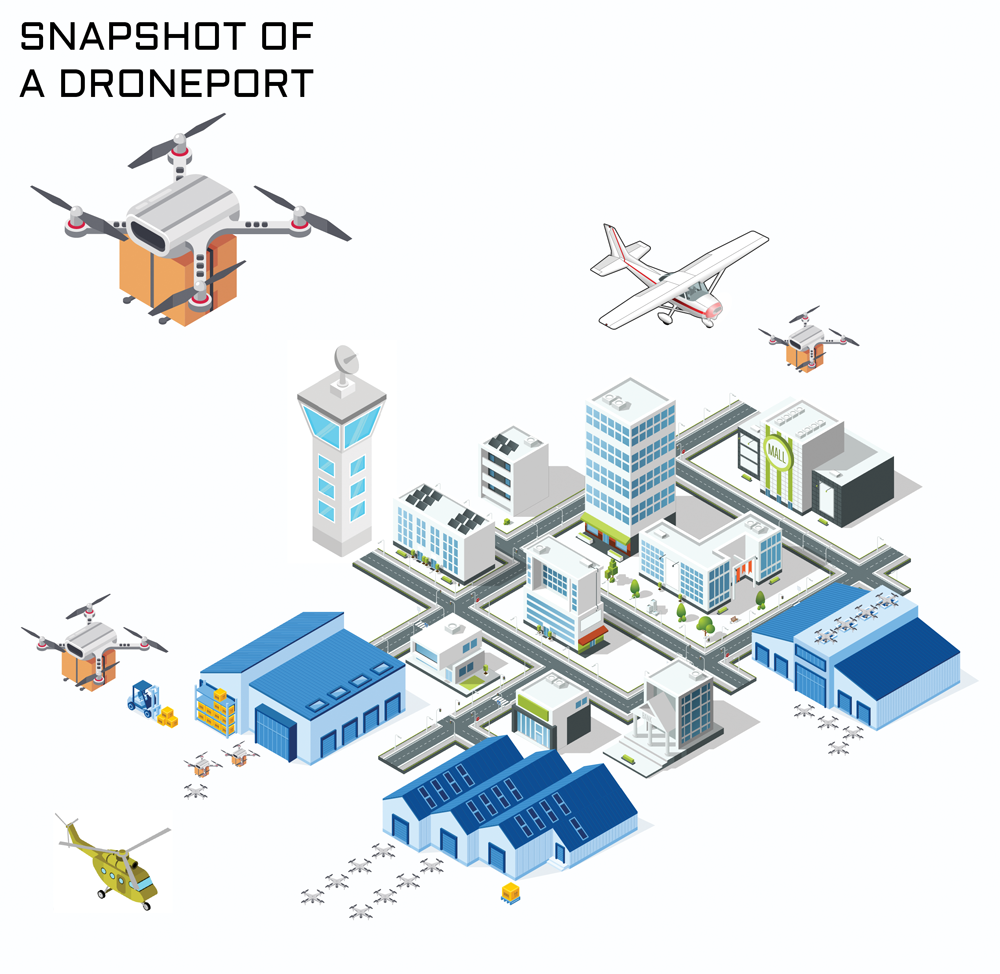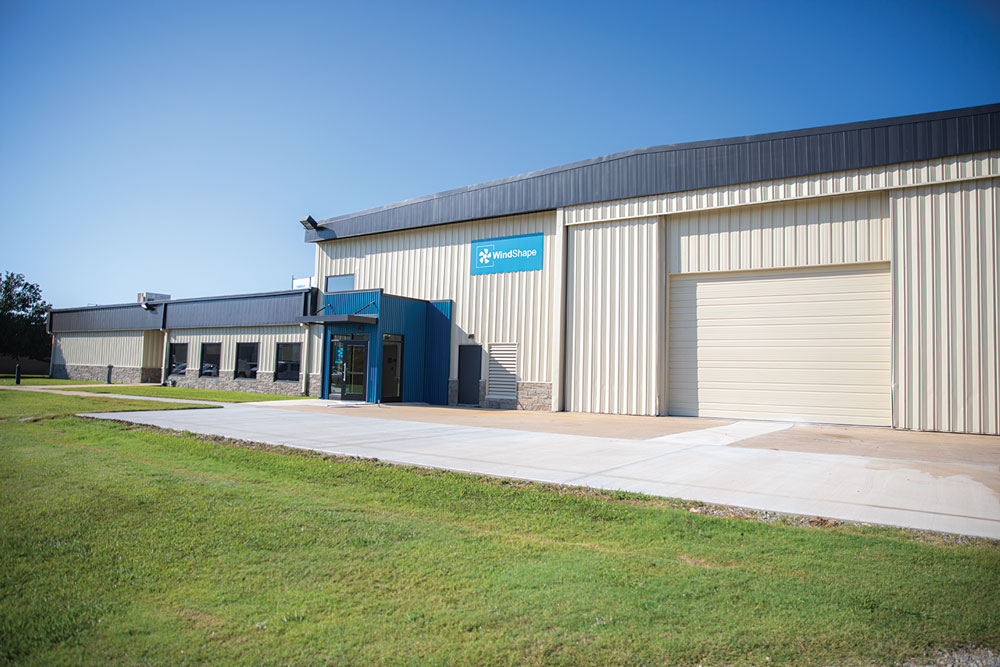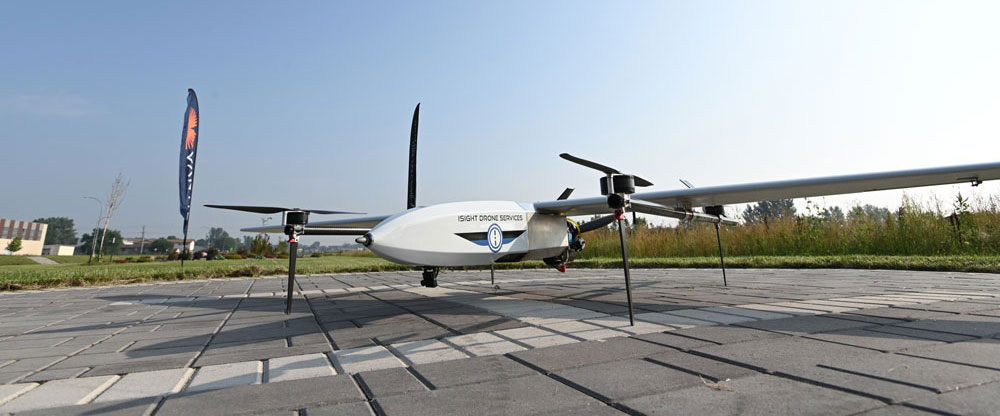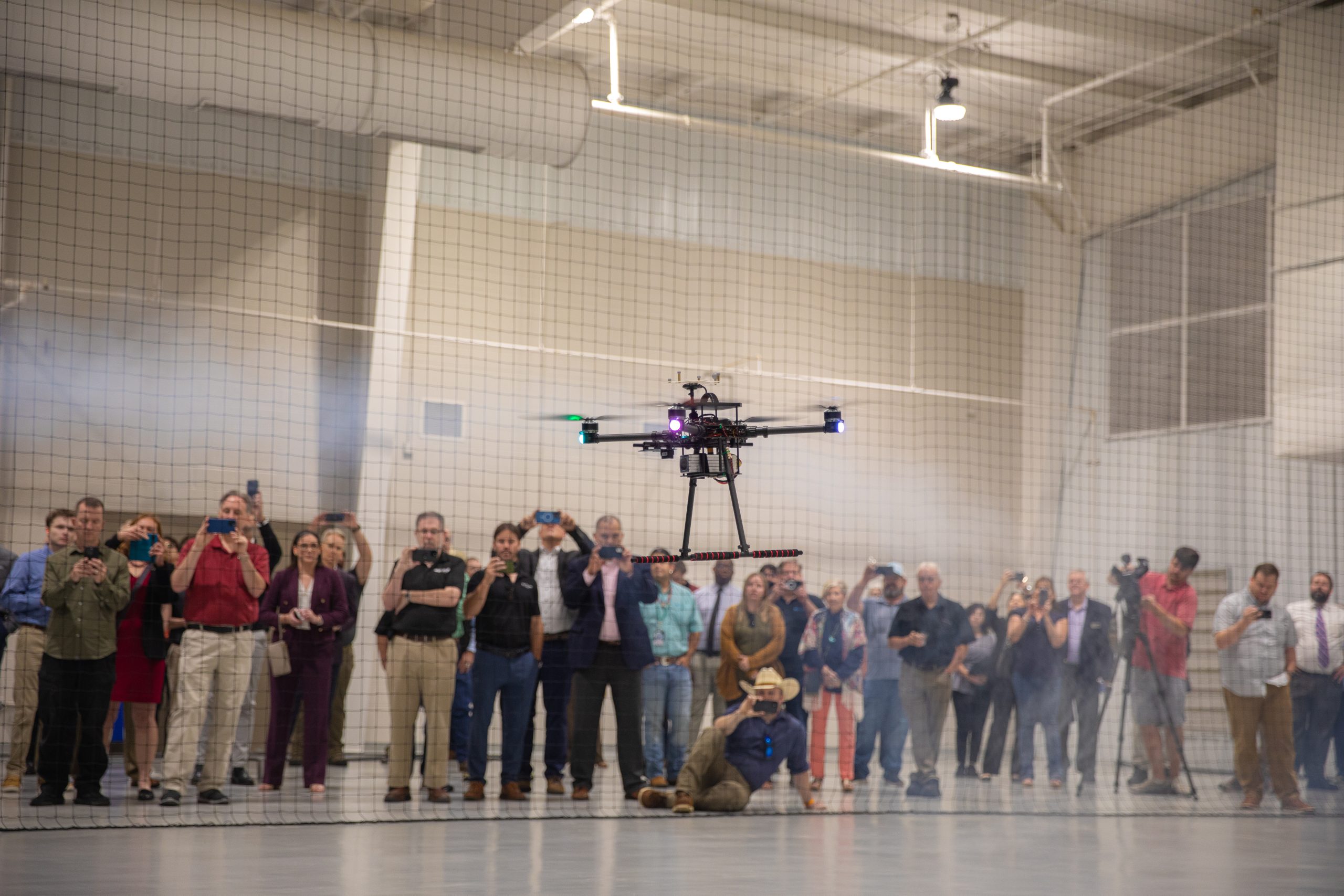Commercial drones will soon be much more than airborne curiosities. They’ll be commonplace additions to communities’ airspace as industries seek to differentiate their product delivery and municipalities use them for first response missions, among other uses. That’s either bad news for locations overwhelmed by how that will work, or it’s good news for communities that have begun the process of planning how to put in place the infrastructure needed to do it right. Their bet is that it will give their location an edge in attracting investment from logistics and other companies wanting to stay ahead of their competition.
The prospect raises more than a few questions. DronePort Network (DPN), based in Oklahoma City, has some answers. The company describes itself as an emerging aerospace infrastructure development company focused on turnkey solutions that will allow communities to support the rapid scalability of drone technology.
In other words, they offer a blueprint for getting the process under way, one that can be tailored to meet specific communities’ needs.

Courtesy of DronePort Network
“A lot of our work has been with communities with an underutilized industrial park or general aviation airport, wondering about the next industry they should be thinking about and whether it involves drones,” says CEO Craig Mahaney. “We help communities think through whether their airspace is set up to support a commercial drone operation, or what the FAA thinks about this. What types of use cases make sense? Who are the technology vendors doing this type of work? What have been the roadblocks? What have been the challenges with community acceptance?”
More than a few questions.

“We help communities think through whether their airspace is set up to support a commercial drone operation.”
— Craig Mahaney, CEO, DronePort Network
DPN hasn’t yet turned a city into a seamless haven for commercial or municipal drone operators to run wild near the local airport. But it’s done plenty of work to set the stage for what lies ahead in this nascent industry.

The WindShape indoor drone testing facility in Tulsa
Photo courtesy of TIL
An Advanced Mobility Cluster Takes Shape
Tulsa Innovation Labs (TIL), a tech-led economic development organization charged with securing Tulsa’s leadership in industries of the future — including advanced mobility, automation and unmanned aerial systems (UAS) — is administering a $39 million federal grant aimed at developing an advanced mobility cluster, among other initiatives, in the northeast Oklahoma city. It hired DPN to help it establish one of the nation’s most ambitious sites for drone testing.
“We now have almost 1,200 square miles in the drone corridor, Skyway Range, the first node of which sits about five miles outside our international airport,” says Jennifer Hankins, TIL’s managing director. “We then started building the beyond visual [line of] sight corridor, where DronePort Network was the anchor in building that capability. We thought about how to test and validate these technologies because not just anything can fly in the sky. DronePort Network is revolutionizing how we are thinking about not a closed system for testing and validation, but how to crack that open for an entire city to be the testing infrastructure itself.”
“Oklahoma is building one of the nation’s most advanced environments for autonomous flight.”
— Guillaume Catry, WindShape CEO

In May, Osage LLC, the business arm of the Osage Nation, integrated Skyway Range into its corporate structure, “providing expanded capabilities and resources for drone testing, training and development,” according to a release. “The consolidation builds upon the existing collaborative relationship between Osage LLC and Skyway Range, that have been partners in developing the Skyway36 DronePort facility.”
“This action represents the next evolution in tribal-led innovation and economic development,” said Russell Goff, CEO of Osage LLC. “By bringing Skyway Range fully into our organization, we’re creating a more integrated approach to UAS infrastructure that will benefit our tribal citizens, industry partners and the broader regional economy. This strategic combination will accelerate our mission to increase prosperity and foster opportunities for the Osage people. The integration strengthens Osage LLC’s position within the Tulsa Regional Advanced Mobility (TRAM) Cluster and enhances its participation in the federally designated Tulsa’s Tech Hub.”
An Indoor Drone Testing Lab
In September, Switzerland-based WindShape, Inc., opened a 20,00-sq.-ft. indoor drone testing facility at Skyway Range on the Osage Nation Reservation. The company says it will offer innovative research and testing of unmanned systems, like drones, not currently available anywhere else in the nation.
“Opening this facility in Tulsa reflects a strategic choice. Oklahoma is building one of the nation’s most advanced environments for autonomous flight,” said WindShape CEO Guillaume Catry. “By combining wind and weather simulation with the region’s strong UAS ecosystem, we are proud to help companies test drones safely, speed certification and create high-skill jobs for the future of aerospace.”
The Tulsa drone hub is more than testing, says TIL’s Hankins. It’s also primed for the manufacture of drones and their components.
“Our vision is that in this industry, drones are tested and made in Tulsa USA,” she says. “We have the capabilities to test thanks to the expertise we bring in, such as DronePort Network and our friends at Osage LLC and Skyway Range. We are also investing heavily in the manufacturing capability and the supply chain.”
Emirates Global Aluminum is investing $4 billion in a smelting facility at the nearby Port of Inola, which will be a key supplier to manufacturing companies in aerospace and drone components, notes Hankins.

“Our vision is that drones are tested and made in Tulsa USA.”
— Jennifer Hankins, Managing Director, Tulsa Innovation Labs
“The issue is building the components at scale,” she says. “That’s through our partners at Cherokee Nation Aerospace and Defense, which is a major contractor already for the Defense Department. They already are manufacturing vertiports and avionics for this industry. They do all that outside of Tulsa and more broadly our region.”
What’s Ahead for Tulsa’s Booming Drone industry?
“It’s fascinating how quickly this industry is changing and for the better — it’s the comprehensiveness of it all,” says Hankins. “We’re not trying to do everything, but for folks aligned with the problems we’re trying to solve, there’s nowhere better in the country. If you need to manufacture something, why would you look elsewhere but Tulsa? When you zero in on aerospace and autonomous systems like drones, I don’t see any other city or region investing at this scale in the infrastructure we’ve built over the last four years.”
National & Global UAS Context & Policy Matters
The 2025 AUVSI Uncrewed Insights report from the Association for Uncrewed Vehicle Systems International performed a historical review of more than 118,000 patent applications related to uncrewed aircraft that were submitted globally since 1980.

The review showed “a substantial surge in patent activity in recent years as the number of applications grew by approximately 650% between 2016 and 2024. China and the U.S. account for more than 70% of these patents with noteworthy interest in swarm technologies and critical infrastructure inspections.”
One indicator the report examined was FAA Part 107 waivers, issued to approve certain operations of aircraft outside the limitations of a regulation.
As of March 1, 2025, there were over 1,200 active FAA Part 107 waivers. “Reviewing approved waiver applications offers valuable insights into the commercial industries actively utilizing drones and the specific use cases involved,” the AUVSI stated, though regulatory shifts such as the 2021 lifting of restrictions on operations at night affect the need for waivers.
Meanwhile, Visual Line-of-Sight (VLOS) waivers data show that “approvals nearly doubled in 2024 compared to the previous year showing a noticeable rise in complex Beyond Visual Line-of-Sight (BVLOS) drone operations.
A new BVLOS rule is anticipated soon from the FAA.
“The distribution of Part 107 waivers across the United States highlights the broad adoption of UAS technology,” the report found, with active waivers in 46 states. High numbers correlate with larger populations, with California, Texas, Florida, New York and Virginia leading the waiver count. But the data also show strong concentrations in less populated areas of states such as Michigan and North Carolina.
“This is mainly due to the utility of drones in areas where traditional infrastructure is either lacking or impractical,” the report notes. “Key sectors benefiting from drone technology in these areas include agriculture, energy and environmental conservation.”
While plenty of state laws have been passed placing restrictions on drone flights, a number of states including Arizona, Oklahoma, Michigan, Florida, Ohio and Texas have passed legislation supporting growth of the UAS industry through streamlined regulation, infrastructure development and workforce development.
The FAA has continued and reauthorized the UAS Test Site Program at these seven sites: Alaska Center for Unmanned Aircraft Systems Integration; Northern Plains UAS Test Site, North Dakota; New Mexico State University UAS Test Site; State of Nevada UAS Test Site; New York UAS Test Site; Texas A&M University Corpus Christi Autonomy Research Institute and the Mid-Atlantic Aviation Partnership in Virginia

In the most recent North American Airport Satisfaction Study, MCI ranked number three in overall customer satisfaction.
In June, President Trump issued two sweeping executive orders focused on strengthening U.S. leadership in UAS by streamlining rulemaking for enabling regulations, fortifying domestic supply chains and promoting manufacturing, advancing security measures and aligning federal operations with emerging aviation technologies.
The orders were universally praised by UAS industry leaders and AUVSI. — Adam Bruns

Photo courtesy of UND Center for Innovation
North Dakota UAS Program Delivers
Potential For Rural Communities
The University of North Dakota Center for Innovation (UND CFI) has completed three successful use case tests for its unmanned aerial systems (UAS) program Project RuralReach. Started in September 2022 with federal grant funding from the U.S Economic Development Administration, the scope of the program has three target areas for the application of UAS technology: rural delivery, sustainable power and emergency response services.
In early 2025, the UND CFI announced a total of $150,000 in awards to three companies ($50,000 each) looking to use UAS technology in rural communities within the state.
iSight Drones was chosen for the rural delivery and supply chain logistics use case test in the western area of North Dakota completed on July 24. Census Technologies was chosen to test the use of UAS for emergency services and disaster responses in the Northeast region of North Dakota with its first flight on September 10.
Botlink, Dunlevy Consulting and Utah State University’s AggieAir were chosen to investigate the use of sustainable power and expand the range of UAS operations, with testing taking place in the southeastern part of the state on September 29.
North Dakota State Senator Jeff Barta, program manager of the Center of Innovation, came onboard as the project was already underway. Barta noted that medical delivery topped the list when it came to priorities in the program.
“What is giving us the greatest return?” Barta asked in an interview with Site Selection. “Human life.”
On July 24, Project Rural Reach had its first successful long-range drone delivery wherein medical supplies were delivered over 80 miles from Williston to McKenzie Health, a local hospital in Watford City, in about 35 minutes. iSight Drone Services of Grand Forks, North Dakota, supplied the SuperVolo drone that completed this mission that will be the first in a series of flight tests.
Barta notes that this operation could lead to saving lives, especially when it comes to delivering medicine in emergency medical events in remote areas of the state.
When asked how UAS technology can be leveraged to boost quality of life, community resilience and economic development in rural areas and in North Dakota generally, Barta notes its application in safety and security.
“If we can launch UAS from a more central location, we can reach a wider area with less boots on the ground,” Barta says. “We want people who enjoy the rural communities to stay in those rural areas if they like it.”
Grand Forks is home to North Dakota State University and UND, both R1 universities known for their work in evolving technologies. Notably, UND was the first college in the U.S. to develop a program focused on UAS pilot training, which launched in 2009. — Kelly Barraza

